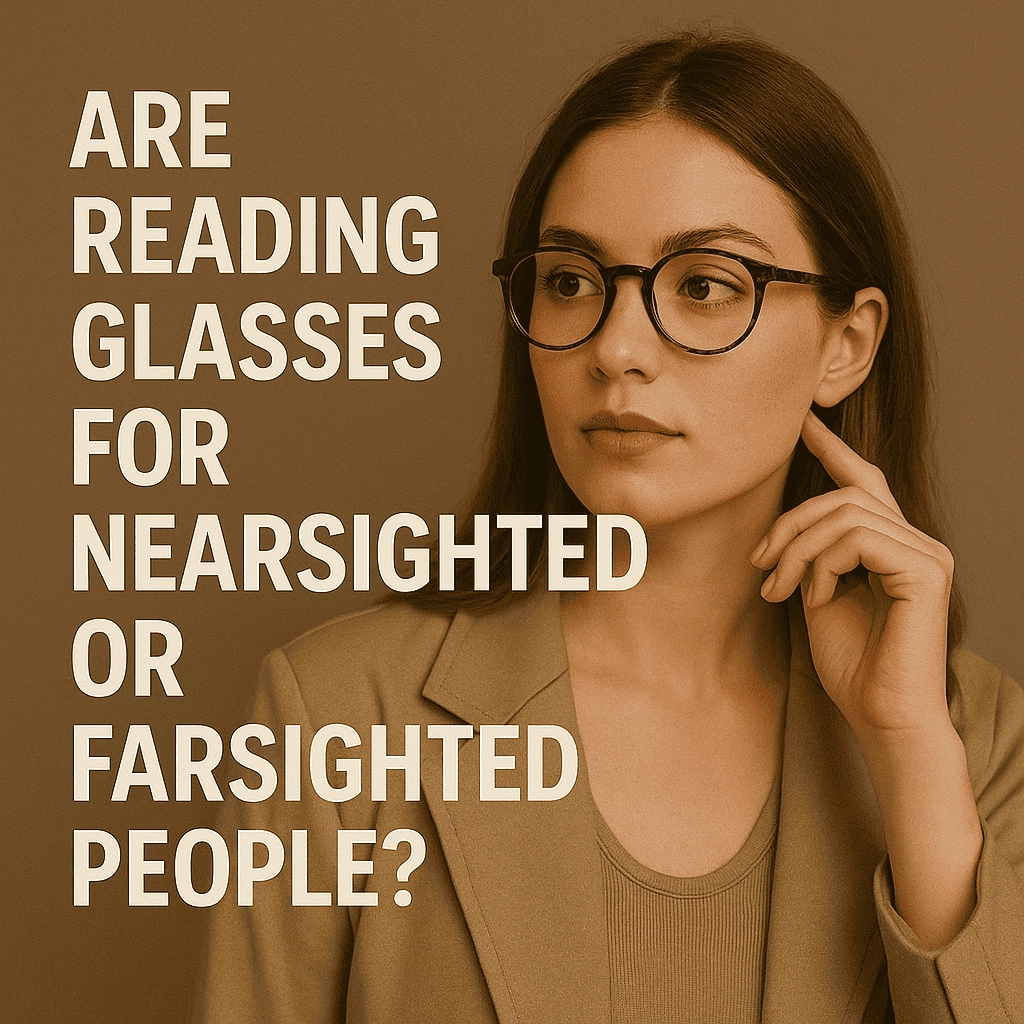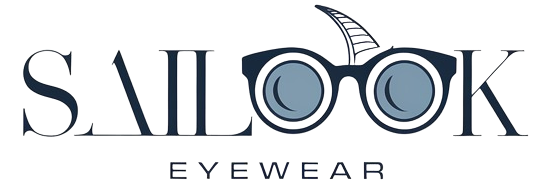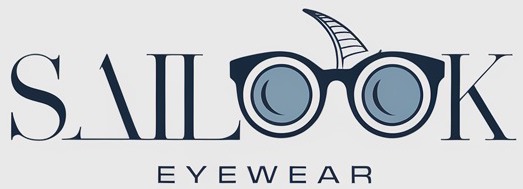Reading glasses are often an essential tool for those dealing with vision challenges. If you’ve ever wondered whether reading glasses are better for nearsighted or farsighted people, you’re not alone. This article dives deep into the topic, offering clarity on how reading glasses work for both conditions. We will explore how reading glasses assist people with different vision problems and how you can select the right pair for your needs. Whether you are nearsighted, farsighted, or dealing with a mix of vision issues, this comprehensive guide will help you make an informed decision.

1. What Are Reading Glasses Used For?
Reading glasses are primarily designed to help people see clearly at close range. They are typically used for tasks such as reading, writing, and working on a computer. The glasses are specifically made to correct near-vision issues, often caused by aging or presbyopia, where the eye’s lens becomes less flexible, leading to difficulty focusing on objects up close.
But here’s the kicker… reading glasses are not one-size-fits-all. They are tailored to different vision needs depending on whether someone is nearsighted, farsighted, or dealing with presbyopia. These glasses help people see fine details more clearly by compensating for deficiencies in their focusing ability.
Reading glasses are available in over-the-counter (OTC) options, but for people with specific vision needs, prescription reading glasses may be necessary. Prescription glasses offer a more personalized fit and correction, addressing not just near-vision, but also potential underlying issues like astigmatism or different focusing strengths in each eye.
Table: Types of Reading Glasses
| Type | Description | Who Needs It |
|---|---|---|
| Over-the-counter (OTC) | Ready-made glasses, often available in pharmacies | People with mild presbyopia |
| Prescription reading glasses | Customized to individual vision needs | People with specific focusing problems or multiple vision issues |
2. Who Needs Reading Glasses?
What’s the real story? Almost everyone will need reading glasses at some point in their life. As we age, our eyes experience changes that make it harder to focus on close-up objects. People with presbyopia, which typically starts in their 40s, are the primary users of reading glasses. However, both nearsighted and farsighted individuals can also benefit from these glasses, depending on their particular vision issues.
For nearsighted individuals (myopes), they often have clear vision for close-up tasks but struggle with distance. Farsighted individuals (hyperopes), on the other hand, experience the opposite problem, finding it challenging to focus on nearby objects while being able to see things at a distance.
This is where it gets interesting… Many people with either nearsightedness or farsightedness still experience difficulties with reading, which is why reading glasses come into play. Even though their distance vision is corrected with regular glasses, close-up work still requires additional help.
Table: Vision Conditions and Their Effects
| Condition | Effect on Vision | Need for Reading Glasses |
|---|---|---|
| Presbyopia | Difficulty seeing up close | Required for close-up tasks like reading |
| Nearsightedness | Clear near vision, blurry distance vision | May need reading glasses for detailed close-up tasks |
| Farsightedness | Difficulty focusing on close objects | Required for reading, writing, and close work |
3. Are Reading Glasses for Nearsighted or Farsighted People?
Here’s the deal… reading glasses are designed primarily for people who have trouble seeing things up close, regardless of whether they are nearsighted or farsighted. However, the way they work differs slightly for each group.
For nearsighted individuals, their eyes naturally focus well on objects that are near, but struggle with objects that are far away. While regular prescription glasses may correct distance vision, reading glasses help nearsighted people focus on fine details when working on tasks like reading a book or looking at a screen.
For farsighted individuals, things are a little different. They have difficulty seeing objects up close but can focus on things in the distance. Farsighted people typically need reading glasses to help them see clearly for close-up tasks, as their eyes struggle to focus on near objects without assistance.
In essence, reading glasses help both nearsighted and farsighted people by improving their near-vision clarity, but the reason for needing them is different for each group.
Table: Reading Glasses for Nearsighted vs. Farsighted People
| Condition | How Reading Glasses Help | What They Correct |
|---|---|---|
| Nearsightedness | Reading glasses help with close-up tasks when distance vision is already corrected | Corrects blurry close-up vision due to presbyopia |
| Farsightedness | Reading glasses help focus on nearby objects that appear blurry | Corrects the inability to focus on close objects |
4. Can Nearsighted People Use Reading Glasses?
You might be wondering, “If I already wear glasses for distance vision, do I really need reading glasses?” The answer is yes, many nearsighted individuals still require reading glasses, especially as they get older and develop presbyopia. In fact, most people who wear glasses for nearsightedness will need an additional pair of reading glasses when they begin to experience trouble focusing up close.
Reading glasses for nearsighted individuals are typically needed for tasks that involve fine detail work like reading small print or working on a computer. These glasses work by magnifying close objects, allowing the nearsighted person to see clearly without straining.
Table: Why Nearsighted People Need Reading Glasses
| Task | How Reading Glasses Help | Why It’s Needed |
|---|---|---|
| Reading small print | Magnifies text for easy reading | Presbyopia may develop with age, affecting close vision |
| Working on a computer | Helps focus on the screen | Even with nearsighted glasses, presbyopia affects near-focus |
5. Can Farsighted People Use Reading Glasses?
Farsighted individuals are more likely to need reading glasses, especially as they age. Since farsightedness causes difficulty in seeing nearby objects, reading glasses can greatly improve the ability to focus on books, phones, and other close-up tasks.
Ready for the good part? Even if someone with farsightedness already wears glasses for distance vision, they will still need reading glasses to focus on close objects. Without the proper correction, tasks like reading or using a smartphone can become frustrating and difficult.
For farsighted individuals, choosing the right strength in reading glasses is important. If the prescription is too strong, it can cause discomfort, while if it’s too weak, it might not correct the vision adequately.
Table: Benefits of Reading Glasses for Farsighted People
| Activity | How Reading Glasses Help | Why It’s Necessary |
|---|---|---|
| Reading a book | Provides magnification for close vision | Without reading glasses, text appears blurry |
| Working on a phone | Enhances clarity for screen tasks | Farsighted people struggle to see up close without glasses |
6. What Is the Difference Between Nearsighted and Farsighted Vision?
What’s the real story? While both conditions deal with vision issues, they affect distance and close-up vision differently. Nearsightedness (myopia) occurs when the eye is too long or the cornea is too curved, making distant objects appear blurry while close objects are clear. Farsightedness (hyperopia), on the other hand, is the result of a shorter eyeball or flatter cornea, which makes close objects appear blurry while distance vision remains clear.
Understanding these differences helps when choosing corrective eyewear. This is where it gets interesting… The correction for these issues can involve either distance glasses, reading glasses, or a combination of both, depending on the severity of each condition.
Table: Nearsighted vs. Farsighted Vision
| Condition | Cause | Effect on Vision |
|---|---|---|
| Nearsightedness | Eye too long, cornea too curved | Clear close-up vision, blurry distance |
| Farsightedness | Eye too short, cornea too flat | Clear distance vision, blurry close-up |
7. Do People with Both Conditions Need Different Reading Glasses?
Here’s the kicker, some people have both nearsightedness and farsightedness. This condition, known as mixed astigmatism, can make finding the right eyewear tricky. People with both conditions may require specialized lenses that can accommodate both issues. Ready for the good part? Progressive lenses, which have multiple focal points, can be a great solution for people with both near- and far-vision problems.
Progressive lenses allow for a smooth transition between distances, providing clear vision at all ranges without the visible lines that bifocal glasses have. This makes them a practical choice for individuals with mixed vision conditions.
Table: Mixed Vision Conditions and Solutions
| Condition | Type of Correction | Recommended Glasses |
|---|---|---|
| Mixed Astigmatism | Both nearsighted and farsighted | Progressive lenses, bifocals |
| Presbyopia + Myopia | Nearsighted and age-related vision | Multifocal or single-vision glasses |
8. What Are the Types of Reading Glasses Available?
Reading glasses come in several types, with varying degrees of customization and material. What’s the real story? Some people opt for off-the-shelf reading glasses available at drugstores, while others prefer prescription reading glasses tailored to their specific vision needs. Prescription glasses can offer more precise correction and comfort, especially for those who need extra help with astigmatism, near-sightedness, or other specific vision impairments.
Off-the-shelf glasses are available in different magnifications, and it’s essential to select the correct strength to ensure comfort and clarity while reading. Prescription reading glasses provide custom lens power, designed specifically for your needs.
Table: Types of Reading Glasses
| Type | Description | Who Needs It |
|---|---|---|
| Over-the-counter (OTC) | Ready-made glasses, often available in pharmacies | People with mild presbyopia |
| Prescription reading glasses | Customized to individual vision needs | People with specific focusing problems or multiple vision issues |
9. How to Choose the Right Reading Glasses for Your Needs
Choosing the right reading glasses involves more than just selecting the right magnification strength. But here’s the kicker… You also need to consider frame size, style, and fit. The right pair of glasses should feel comfortable on your face without slipping or pressing against your nose. It’s important to keep in mind the materials used in the frame and lens, as well as the quality of the optics.
When selecting the strength of your reading glasses, it’s best to visit an eye care professional for a full assessment. This ensures you select the most appropriate lens strength for your specific condition.
Table: Choosing the Right Reading Glasses
| Factor | What to Consider | Why It’s Important |
|---|---|---|
| Lens Strength | The correct magnification for close-up tasks | Too strong or weak can cause discomfort |
| Frame Fit | Frame shape and comfort level | Proper fit prevents discomfort or slippage |
| Lens Material | Lens type (e.g., plastic, glass, polycarbonate) | Affects durability, weight, and comfort |
10. How Do Reading Glasses Work to Correct Vision?
Reading glasses are equipped with magnifying lenses designed to help focus light properly onto the retina. What’s the real story? When we experience presbyopia or other vision issues, our eyes cannot focus on nearby objects effectively. The convex lenses in reading glasses bend light entering the eye, allowing it to focus on the retina and make close-up objects appear clear.
The lenses in reading glasses may be single vision lenses or multifocal lenses, depending on your needs. Single vision lenses correct one field of vision, while multifocal lenses, such as bifocals and progressives, correct multiple fields of vision.
Table: Types of Lenses for Reading Glasses
| Lens Type | Purpose | Best For |
|---|---|---|
| Single Vision Lenses | Corrects one field of vision | People with presbyopia or mild focusing issues |
| Bifocal and Progressive Lenses | Corrects multiple distances | People with both near and far vision issues |
11. Can Reading Glasses Help with Eye Strain?
Many individuals suffer from eye strain, especially those who spend extended periods working on screens or reading fine print. But here’s the kicker… Reading glasses can help reduce the strain caused by prolonged close-up tasks. The magnification in the lenses allows your eyes to focus more comfortably, reducing the effort needed to see fine details.
Eye strain can lead to headaches, blurred vision, and even neck or shoulder discomfort. By using the right pair of reading glasses, many individuals find that their strain is significantly reduced.
Table: Common Causes of Eye Strain
| Cause | Symptoms | Solution |
|---|---|---|
| Prolonged screen time | Headaches, blurry vision | Reading glasses for close-up work |
| Poor lighting conditions | Eye fatigue, difficulty reading | Use of proper lighting and reading glasses |
12. How Often Should You Replace Your Reading Glasses?
What’s the real story? Reading glasses don’t last forever, and their effectiveness can diminish over time. If you notice discomfort, blurry vision, or difficulty focusing, it might be time for a replacement. Generally, most people need new reading glasses every 1-2 years, depending on how their vision changes and the wear and tear on the glasses.
If you’ve noticed your vision becoming less clear with your current pair, it’s a good idea to have an eye care professional evaluate whether a new prescription is needed.
Table: When to Replace Your Reading Glasses
| Sign of Need for Replacement | Possible Cause | Solution |
|---|---|---|
| Blurry vision | Changes in eyesight | Get a new prescription or pair |
| Frequent headaches | Inaccurate prescription strength | Adjust lens power or frame fit |
13. Can You Use Reading Glasses for Other Activities?
Ready for the good part? Many people wonder whether they can use their reading glasses for other tasks besides reading. The short answer is: it depends. If you’re doing activities like working on a computer or using your phone, you may find reading glasses helpful, but they are generally not designed for activities like driving or playing sports.
If you find that your reading glasses are helping with tasks outside of close-up work, you might want to consider getting a pair of computer glasses or specialized lenses designed for the specific activity.
Table: Activities and Glasses Usage
| Activity | Suitability for Reading Glasses | Need for Specialized Glasses |
|---|---|---|
| Reading and writing | Excellent fit | No need for alternatives |
| Computer work | Can help, but not ideal for prolonged use | Computer glasses recommended |
| Driving | Not suitable | Prescription glasses needed for distance vision |
14. Are There Any Risks or Side Effects of Using Reading Glasses?
While reading glasses are generally safe and effective, there are a few potential risks to consider. But here’s the kicker… Using the wrong strength of reading glasses can cause discomfort, including headaches, dizziness, and blurry vision. It’s important to get the correct prescription from an eye care professional to avoid these issues.
Over-reliance on reading glasses can also lead to eye strain, particularly if they’re used for tasks beyond their intended purpose. It’s crucial to use reading glasses only when needed and take breaks from close-up work.
Table: Risks of Using the Wrong Reading Glasses
| Risk | Cause | Prevention |
|---|---|---|
| Headaches and dizziness | Incorrect prescription strength | Get a proper prescription |
| Eye strain | Prolonged use without breaks | Take regular breaks from close work |
15. How Can You Maintain Your Reading Glasses?
Taking care of your reading glasses is essential for ensuring they last longer and continue to provide effective vision correction. What’s the real story? Regular cleaning, proper storage, and avoiding physical damage can extend the life of your glasses.
Always use a microfiber cloth to clean your lenses and store your glasses in a hard case when not in use. Avoid placing them on surfaces where they can be scratched or damaged. By maintaining your glasses, you’ll ensure they provide optimal performance for as long as possible.
Table: Reading Glasses Maintenance Tips
| Tip | Why It’s Important | Best Practice |
|---|---|---|
| Regular cleaning | Keeps lenses clear and scratch-free | Use microfiber cloth and lens cleaner |
| Proper storage | Prevents damage and scratches | Store in a hard case when not in use |
Conclusion
In summary, reading glasses are a valuable tool for both nearsighted and farsighted individuals, helping to improve close-up vision for tasks such as reading, writing, and screen use. Whether you have presbyopia, nearsightedness, or farsightedness, the right pair of reading glasses can make a significant difference in daily comfort and productivity. It’s important to understand your specific vision needs and choose the right glasses based on your unique condition. Regular eye check-ups and proper glasses maintenance are essential for ensuring that your vision stays clear and comfortable over time.
FAQ Section
Q1: What is the purpose of reading glasses?
Reading glasses are designed to help improve close-up vision, making tasks like reading, writing, and working on a computer easier for people with vision issues such as presbyopia or farsightedness.
Q2: How do reading glasses help nearsighted and farsighted people?
Nearsighted people use reading glasses to magnify close-up objects that are hard to see clearly. Farsighted people use reading glasses to focus on nearby objects that appear blurry.
Q3: Can I use reading glasses for computer work?
Reading glasses can assist with close-up tasks, but for extended computer work, it might be better to use glasses specifically designed for screen use, which reduce eye strain.
Q4: How often should I replace my reading glasses?
It’s recommended to replace your reading glasses every 1-2 years, or sooner if you notice that your vision is not as clear as it used to be.
Q5: Are there any risks with using reading glasses?
Using the wrong prescription strength can cause discomfort, headaches, and eye strain. Always ensure your prescription is up to date for optimal performance.

